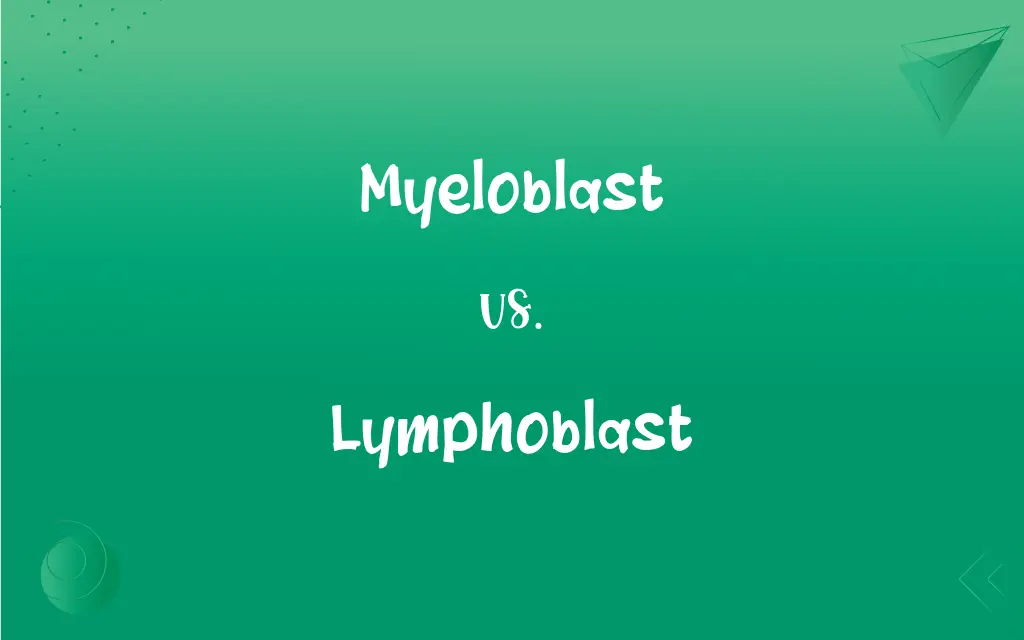Myeloblast vs. Lymphoblast: What's the Difference?
Edited by Aimie Carlson || By Harlon Moss || Updated on October 29, 2023
Myeloblasts are immature cells that develop into white blood cells called granulocytes, while lymphoblasts are immature cells that develop into lymphocytes.

Key Differences
A myeloblast is a type of immature white blood cell that is found in the bone marrow and is a precursor to granulocytes. These cells are involved in the body's immune response and help to fight off infections. Myeloblasts are typically larger and have a more irregular shape than lymphoblasts.
A lymphoblast, on the other hand, is a type of immature white blood cell that is a precursor to lymphocytes. Lymphocytes are a crucial component of the body's immune system and are involved in the production of antibodies. Lymphoblasts are typically smaller and have a more uniform shape compared to myeloblasts.
The key difference between myeloblasts and lymphoblasts lies in the types of mature white blood cells they develop into. Myeloblasts develop into granulocytes, which are part of the innate immune system, while lymphoblasts develop into lymphocytes, which are part of the adaptive immune system.
It is important to note that both myeloblasts and lymphoblasts play critical roles in the body's defense against infections and diseases. Abnormalities in these cells can lead to various types of leukemia, which is a type of cancer that affects the blood and bone marrow.
Comparison Chart
Definition
Immature cell developing into granulocytes
Immature cell developing into lymphocytes
ADVERTISEMENT
Size
Typically larger
Typically smaller
Shape
Irregular
Uniform
Part of Immune System
Innate
Adaptive
Related Diseases
Myeloid leukemia
Lymphoblastic leukemia
Myeloblast and Lymphoblast Definitions
Myeloblast
Myeloblasts are part of the innate immune system.
Myeloblasts help fight off infections.
ADVERTISEMENT
Lymphoblast
Lymphoblasts are found in the bone marrow.
Lymphoblasts develop into lymphocytes, which are white blood cells.
Myeloblast
Myeloblasts are crucial for the body's defense against diseases.
Myeloblasts play a role in the immune response.
Lymphoblast
Lymphoblasts are immature white blood cells that develop into lymphocytes.
Lymphoblasts are involved in antibody production.
Myeloblast
Myeloblasts are typically found in the bone marrow.
Myeloblasts develop into granulocytes, which are white blood cells.
Lymphoblast
Lymphoblasts are smaller and have a more uniform shape compared to myeloblasts.
Abnormal lymphoblasts can lead to lymphoblastic leukemia.
Myeloblast
Myeloblasts are immature white blood cells that develop into granulocytes.
Myeloblasts are found in the bone marrow.
Lymphoblast
Lymphoblasts are part of the adaptive immune system.
Lymphoblasts are crucial for the body's immune response.
Myeloblast
Myeloblasts are larger and have an irregular shape compared to lymphoblasts.
Abnormal myeloblasts can lead to myeloid leukemia.
Lymphoblast
Lymphoblasts are involved in the production of antibodies.
Lymphoblasts help fight off infections.
Lymphoblast
A large, immature lymphocyte that has been activated by an antigen and divides to give rise to mature lymphocytes (B cells and T cells).
Lymphoblast
An immature lymphocyte; they proliferate uncontrollably in lymphoblastic leukemia
Lymphoblast
An immature lymphocyte
FAQs
What is a myeloblast?
An immature white blood cell that develops into granulocytes.
What is a lymphoblast?
An immature white blood cell that develops into lymphocytes.
What is the innate immune system?
The body's first line of defense against infections.
Can abnormalities in myeloblasts lead to leukemia?
Yes, abnormal myeloblasts can lead to myeloid leukemia.
Where are lymphoblasts found?
In the bone marrow.
What role do lymphoblasts play in the immune response?
They develop into lymphocytes, which produce antibodies.
What are granulocytes?
A type of white blood cell that is part of the innate immune system.
Where are myeloblasts found?
In the bone marrow.
Are lymphoblasts part of the innate immune system?
No, they are part of the adaptive immune system.
Can myeloblasts develop into lymphoblastic leukemia?
No, they can develop into myeloid leukemia.
Can lymphoblasts develop into myeloid leukemia?
No, they can develop into lymphoblastic leukemia.
What are lymphocytes?
A type of white blood cell that is part of the adaptive immune system.
What is the adaptive immune system?
The body's second line of defense that adapts to specific infections.
Do lymphoblasts develop into granulocytes?
No, they develop into lymphocytes.
Are myeloblasts part of the adaptive immune system?
No, they are part of the innate immune system.
Do myeloblasts develop into lymphocytes?
No, they develop into granulocytes.
Are myeloblasts larger or smaller than lymphoblasts?
They are typically larger.
Are lymphoblasts larger or smaller than myeloblasts?
They are typically smaller.
What role do myeloblasts play in the immune response?
They develop into granulocytes, which help fight off infections.
Can abnormalities in lymphoblasts lead to leukemia?
Yes, abnormal lymphoblasts can lead to lymphoblastic leukemia.
About Author
Written by
Harlon MossHarlon is a seasoned quality moderator and accomplished content writer for Difference Wiki. An alumnus of the prestigious University of California, he earned his degree in Computer Science. Leveraging his academic background, Harlon brings a meticulous and informed perspective to his work, ensuring content accuracy and excellence.
Edited by
Aimie CarlsonAimie Carlson, holding a master's degree in English literature, is a fervent English language enthusiast. She lends her writing talents to Difference Wiki, a prominent website that specializes in comparisons, offering readers insightful analyses that both captivate and inform.































































